Out of sync
Seasons are shifting, but some creatures—and laws—aren't
Mar 15, 2012 - by Staff
Mar 15, 2012 - by Staff
March 19, 2012 • Ah, spring. From ancient civilizations on, what poet hasn’t greeted the season of longer days, increasing warmth, melting snow, and blooming flowers? But today’s poets may have to revise their odes.
Spring blooms got a head start with the Great Warm Wave of March 2012, as record-setting temperatures swept across much of the eastern United States. Many of the famed cherry blossoms in Washington, D.C., were in full bloom days before the opening of the National Cherry Blossom Festival and the associated 100th anniversary celebration of the first official donation of cherry trees from Japan.
Bloom watchers across the country can share their sightings this year in the Cherry Blossom Blitz. The six-week campaign is organized by Project BudBurst, an ongoing citizen-science effort at the National Ecological Observatory Network. New or returning participants in BudBurst can sign up for the blitz, which runs from March 20 to April 30, at the project website.
Many signs of spring have shifted earlier and earlier, out of sync with the lengthening days. Warmer weather, snowmelt, and flowers, for example, are now arriving during what used to be winter in many parts of the globe. Evidence is growing that some animals and insects aren’t adapting fast enough to the changes in timing of the seasonal signs, and that the consequences of that failure can be disastrous.
Legislators have also greeted the seasons, typically with regulations governing water use, hunting, grazing on public lands, and other seasonal activities. And like other creatures, people are beginning to feel the effects of the increasing disconnect between the permanent dates written into these laws and the changing seasons.
It’s taken scientists a while to respond to the issue—sometimes referred to as seasonal asynchrony—which has a distinct set of consequences beyond those of more commonly recognized indicators of global climate change. Specific populations are being put at risk, including migratory animals and people governed by date-specific laws that no longer match reality.
Biologists only began researching the effects on vulnerable animal populations in the early 2000s. A few social scientists have recently begun looking at how human populations are also being affected, particularly in Alaska, one of the fastest-warming places on Earth. And just within the last decade, experts in environmental law have begun questioning the consequences of outdated policies on agriculture and water supplies.
This area of study is so new, according to NCAR postdoctoral researcher Shannon McNeeley, that it’s suffering from a lack of a comprehensive view.
“Some people focus on changing seasonality from either a biological or a climate point of view, and a small but growing community study the links between changing seasonality and policies,” McNeeley says. “There aren’t many yet who do truly comprehensive social and natural science research from a systems point of view by integrating social science, climatology, and ecology to understand how this affects vulnerable livelihoods on the ground.”

Shannon McNeeley. (©UCAR, Photo by Carlye Calvin. This image is freely available for media & nonprofit use.*)
Here’s a brief overview of research emerging on the effects of seasonal mistiming.
Warmth governs the ability of seeds to germinate, the dates of snowmelt, and other triggers of the growing season.
There’s copious documentation that plant growth is shifting earlier in response to a warmer climate. The U.K.’s Royal Botanic Gardens, Kew, has been tracking first flowering dates for some 100 species since the 1950s; snowdrops are now flowering 10 days earlier on average, and spring narcissus almost two weeks earlier. In the United States, the flowering date for winter wheat, a major crop of the High Plains, has advanced by one to two weeks since World War II, marching forward 0.8–1.8 days per decade over the last 70 years.
Among animals and insects, however, the situation isn’t so straightforward. Researchers have been aware for some time that warming is changing the geographic range of species. For example, a 1996 study by Camille Parmesan (University of Texas) noted the range shift of a California butterfly northward and to higher altitudes.
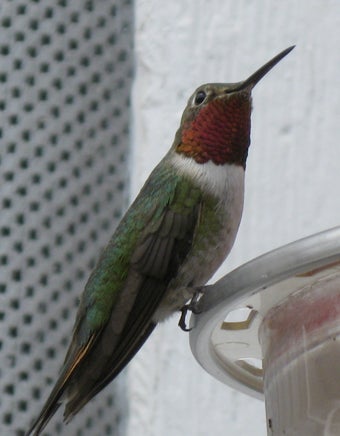
A broad-tailed hummingbird. (Photo by Carol Rasmussen.)
Migratory and hibernating animals may take their cues to move from increasing or decreasing sunlight or from temperature changes in their current habitat (spring warming in their wintering grounds, for example). In either case, the migrators may arrive at their destination habitat to find that it’s out of sync with their needs if climate change is producing different results there. When that happens, the consequences ripple through entire ecosystems.
The full extent to which the seasonal drift is putting plants and animals at risk is not yet known. One of the first studies of multiple species was a 2005 paper by Dutch ecologists. Searching for long-term datasets covering both vulnerable species and their food sources, the authors found adequate information for only 11 species. In this small sample, however, 8 species—including birds, insects, and zooplankton—had changed their behavior either too little or too much, so they were out of sync with their food sources. Only 3 species were adapting in sync.
David Inouye (University of Maryland) has records on the arrival of broad-tailed hummingbirds and American robins at a high-altitude research station near Crested Butte, Colorado, that date back to the early 1970s. “These migrating species are getting cues from conditions at their wintering grounds that are no longer as reliable as they used to be, because of climate change,” he says. Robins are now arriving 14 days earlier than in 1981, but although snowpack is melting sooner over most of the Rockies, at this particular site the snowmelt date hasn’t changed much yet. The gap between the birds’ arrival and the first date of bare ground has grown by 18 days. In some years, the robins have arrived to find almost six feet (two meters) of snow on the ground. Unable to feed, they then have to fly back down to lower elevations and wait for the snow in their breeding grounds to melt.
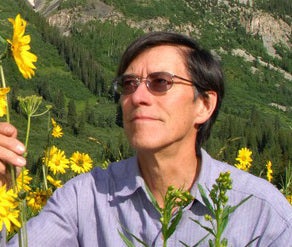
David Inouye. (Courtesy photo.)
The wildflowers at the Crested Butte site are suffering from a different problem. A 17-year study of glacier lilies has found that pollination of these early spring wildflowers is declining. Their pollinators are the broad-tailed hummingbirds and bumblebees, which spend the winter underground. The bumblebees’ emergence dates have not shifted forward. As for the hummingbirds, “They’re arriving earlier, but not as early as the wildflowers,” Inouye says. “If flowers are blooming and the pollinators have not yet arrived, that could put the flowers at risk of extinction, because if they’re not pollinated they’re not making seeds.”
Seasonal drift has already led a few species within sight of extinction. One is migratory caribou. Since biologist Eric Post (Pennsylvania State University) began studying caribou in Greenland in 1993, spring temperatures have risen by about 7°F (4°C), and plant cycles have shifted forward to match. Caribou calves, however, are still being born at about the same time each year. The problem is that now, the early plants are past their nutritional peak when the calves begin to forage. The number of calves surviving into adulthood decreased by 75% from 1993 to 2008.
“I had no idea caribou could be on the brink of collapse,” Post said in 2009. “They seemed to have all the right traits to adapt. The rate of change is so fast now. For a long-lived species, there’s no chance for evolution to keep up.”
Like the Arctic caribou, human populations at high latitudes are experiencing the greatest changes in seasonal timing, and that’s where current impacts may also be greatest.
McNeeley has studied how this problem is playing out for one such vulnerable group in Alaska. The Koyukon Athabascan people rely on autumn moose hunts to keep them fed over the winter. Their legal hunting season is the period when, historically, moose were leaving their summer habitat of high-elevation lakes to follow rivers downhill in search of mates. But the law and the season no longer match.
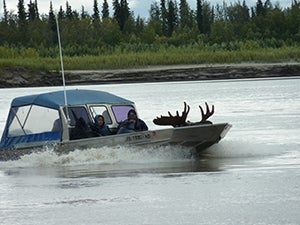
Alaska Natives in the Koyukuk-Middle Yukon region return from a successful moose hunt. (Photo by Shannon McNeeley, NCAR.)
“The elders talk about how September weather is now what August conditions used to be, which is warmer and wetter,” McNeeley says. “That means that when the hunters have the open window, legally, for the moose hunt, the moose are still in the higher elevations. The Koyukon are stuck between a rock and a hard place: they have a choice of not having enough meat through the winter or hunting illegally.”
Hunting seasons in Alaska are regulated by multiple agencies and boards at several levels of government. The Koyukon have appealed many times to these bodies for a change in season, but so far their appeals have all been fruitless—except one. “The one time a board approved a proposal, it was because of moose conservation concerns,” McNeeley explains. Because the bulls lose their antlers in winter, making it more difficult for a hunter to distinguish between a male and female, biologists worry that hunting then is more likely to result in the death of a breeding female. So the board supported extending the fall hunting season to cut down on illegal hunting in winter.
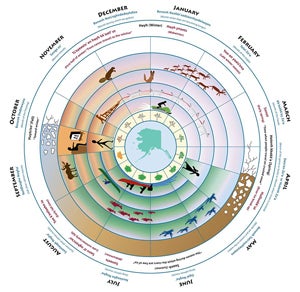
This "seasonal round" graphic shows the relations between the Western calendar, the lifeways of Koyukon people, and the ecosystems with which they interact. (Image ©Shannon McNeeley. Reprint with permission only.)
The lesson of this experience, according to McNeeley, is that “it’s in the best interest of the regulators to work with the locals. They’re actually the stewards of the animal population. They’re the ones who will enable you to conserve.” McNeeley has summarized her work on Alaska's changing seasonality and vulnerability in the journal Global Environmental Change (see abstract) and the regional options for sustainable adaptation to seasonal shifts in the journal Climatic Change (see open access article).
In the western United States, a region long known for wrangling over water and other policy issues, the drifting seasons offer a new layer of challenge. Water-use laws and compacts governing the arid western states were hammered out in the 19th and 20th centuries through conflicts that ranged beyond words to armed battles. Farmers and politicians alike are beginning to understand that the changing seasons are rendering some of those hard-won policies obsolete. But updating them may be almost as difficult as creating them was.
The process is bound to be cumbersome. Water rights are the subject of federal, state, and local laws as well as interstate compacts, and they’re administered by a tangled web of regulatory agencies and bodies. But the fundamental problem is the scarcity of the resource, according to Douglas Kenney, director of the Western Water Policy Program at the University of Colorado. “When you’re talking about water rights, you’re dealing with a zero-sum game. Whatever trend you want to impose on the system, it’s going to benefit somebody at the expense of somebody else. So changing the rules is controversial, but not changing them is also controversial.”
The bellwether sign of a changing spring in the western United States is snowmelt, which is shifting to earlier dates at a breakneck pace almost everywhere. In the Pacific Northwest, the highest spring streamflows are now as much as 20 days earlier than they were in the 1950s. Kenney and colleagues wrote a 2008 report (PDF) for the Western Water Assessment on how the earlier spring snowmelts are affecting the administration of water rights.
“Water law looks very specific and clear, but when you get out in the field you find that the way the laws are administered is pretty flexible," Kenney explains. "It might not always look like the letter of the law, but it’s a workable arrangement.”

Douglas Kenney. (Photo courtesy University of Colorado.)
So far, that flexibility has been sufficient to adapt to the changing conditions, but Kenney notes that it’s now stretched to the breaking point. “Colorado water administrators, for example, report that some ‘gentlemen’s’ agreements’ regarding diversion schedules among water users are eroding,” he says.
Among U.S states, the flashpoints for change are likely to be those with both faster rates of climate change and more inflexible regulations, such as Oregon. However, Kenney points out, “It’s case specific. I think you’ll see some of the biggest conflicts at the beginning of the season between people who have the right to divert water into a reservoir and those who have a direct-flow right and are trying to begin irrigating their crops.”
Since the 2008 report, Kenney has continued to monitor the issue. “This problem only gets worse over time, and there’s often no obvious technical solution,” he says. “It’s going to require solutions that are political in nature.”
To improve the outlook for vulnerable human populations, McNeeley would like to see more, and more comprehensive, work from a systems perspective that combines climate and seasonality data, local observations and impacts, and an integrated view of social and ecological systems. “This is the kind of research that’s needed wherever climate-sensitive livelihoods and policies are embedded in legal and regulatory structures,” she says.
Parmesan, the researcher who studied the California butterfly, is one of a few scientists who are advancing an environmental policy idea that was considered too risky as recently as the 1990s: assisted migration, that is, moving endangered species to new habitats and corridors where they might thrive. Although the idea won’t work for all threatened species, Parmesan believes that it could save at least some from extinction. She and colleagues in Australia and the United Kingdom have created a conceptual framework for choosing candidate species.
The dangers of such a project are obvious to anyone familiar with kudzu or zebra mussels: if the selection process is not thorough and careful enough, the result could be a new set of problems as damaging as the ones those invasive species are causing. But Parmesan is convinced that this kind of intervention is both feasible and necessary.
“We need to create systems that we believe will be most suited to an area for the next 100 to 200 years of climate change,” she said in 2010. “This could mean putting species together that don’t reasonably exist together right now, but will exist in the climates we can expect to come. I think that’s where ecology needs to be going, where the science needs to be going.”
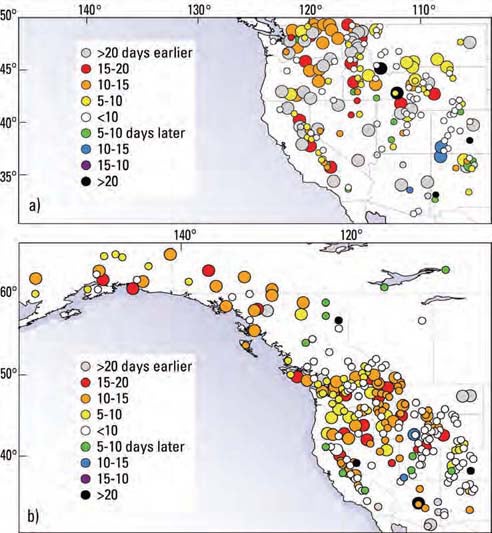
Trends between the 1950s and 1990s in (a) yearly dates of spring snowmelt onset and (b) centers of volume of yearly streamflow hydrographs in rivers throughout western North America, based on U.S. Geological Survey streamgages in the United States and an equivalent Canadian streamflow network. Large circles indicate sites with trends that differ significantly from zero at a 90-percent confidence level; small circles are not confidently identified. (Image from "Changes in Streamflow Timing in the Western United States in Recent Decades," U.S. Geological Survey, 2005, Figure 4.)